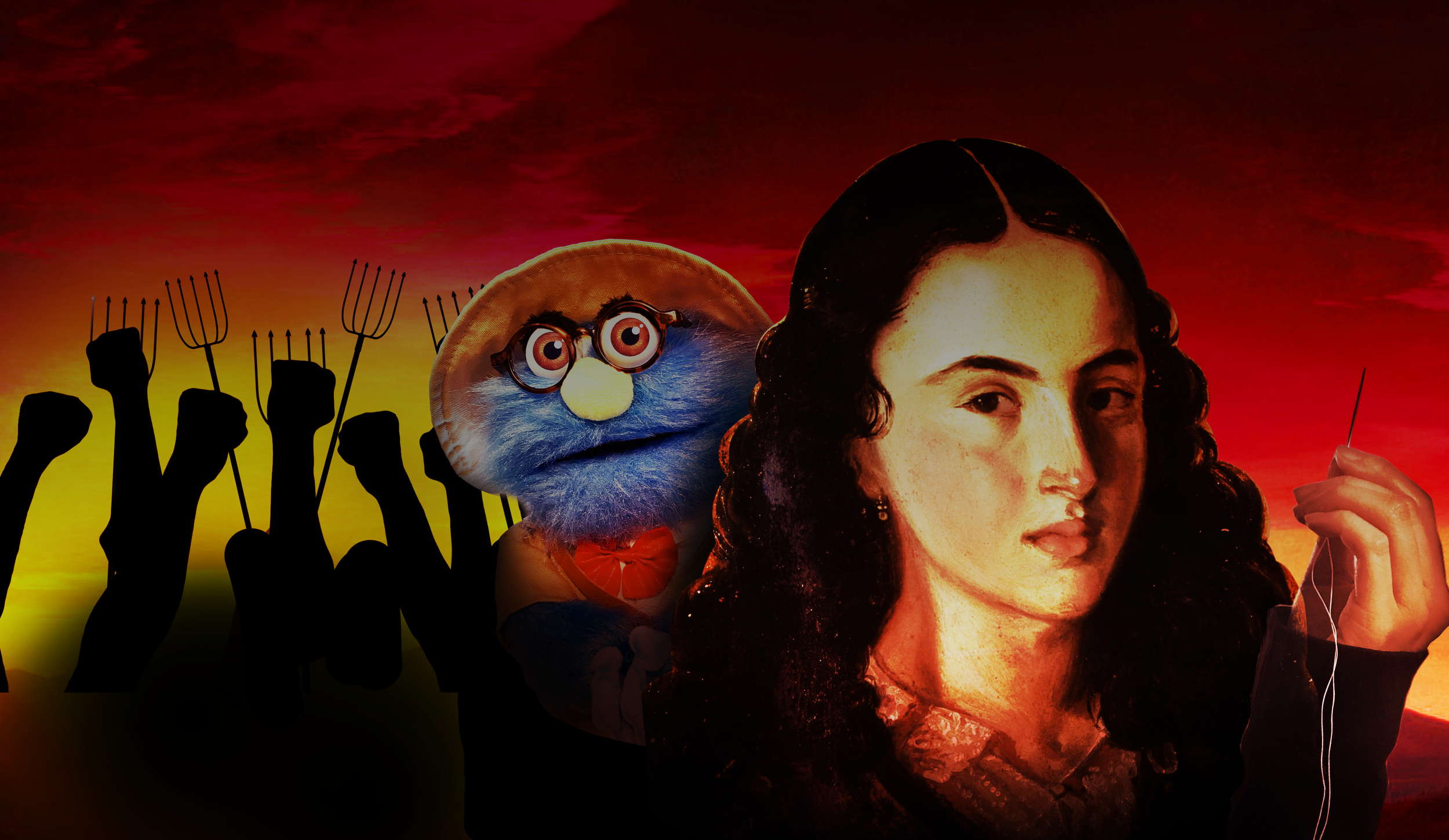
LESSON 07 - Policarpa: The Revolutionary Teen Spy
Hello! And welcome to the penultimate week of the Puppet University fall semester. I’m your TA, writer and researcher Kari Koeppel, here to dive deeper into The Professor’s lesson of the week.
But first, a comment from one of your classmates regarding last week’s class on samurai Miyamoto Musashi that I found particularly enlightening.
I had no idea! I looked it up, and Lauren’s totally right. What a fun fact! Musashi is a type of gene that, when mutated, leads to the generation of two identical non-neural precursor cells. Tbh, as someone who frankly has not studied anything to do with cells in nigh on a decade (oh god I’m so old) I can’t explain it in any more detail than this, but this gene was named after Musashi and his use of two swords in the early 1990s by a group of scientists led by neurobiologist Craig Montell. It looks like the Musashi gene has been studied a great deal in connection to cancer. But I just think it’s interesting to see what fun names pop up in science!
Now onto today’s subject (and the subject of a chapter in my book, Strong Women), Colombian hero Policarpa Salavarrieta. Just in time for Latinx Heritage Month! And yet another area of history that the U.S. does not teach in schools!!!! In California, we learned some Mexican history only because it’s partially ours, too; but in researching Policarpa I realized that I had no idea how all of South America eventually gained its independence from Spanish and Portuguese rule. And I had no idea Napoleon had ever taken over Spain? *sobs* U.S. education system, why have you forsaken me?!
First, a quick note on the era in which Policarpa was active, mainly that her period of history now has a title that makes me chuckle. Is this week’s newsletter mostly about how I’m amused by naming conventions? Don’t get me started on how nail polishes get named! Anyway, the period of time in which Latin American juntas were taking advantage of King Ferdinand being MIA to explore the idea of freedom (1810-1816) is now known as “La Patria Boba,” or The Foolish Fatherland. Historians gave it this name basically as a diss, referencing how the mission during La Patria Boba ultimately failed (lol) and how overall, it was just badly organized and implemented, like on every level. Historians can be so snarky, and I love that for them.
I also wanted to elaborate a bit more on the play about Policarpa’s life that The Professor mentioned, where the crowd rioted when it came time for Policarpa to be executed. The play was first performed in a Bogota theatre on July 23, 1820, and like The Professor said, the audience intervened to prevent Policarpa’s execution. Order was only restored to the theatre when the management persuaded the audience to shout, as some legends say that Policarpa did in the face of her execution, “Viva la Patria!” The riot was thus transformed into a celebration. However, after this first performance, the playwright decided it might be best to change the play’s ending, and, ya know, prevent nightly riots. Rather than having Policarpa shot by a firing squad, the play instead ends with her entering the ~immortality of history~, which sounds almost Biblical!

Two other fun facts about Policarpa’s legacy: In 1910, on the 100th anniversary of Colombian independence, the Bavaria brewery released Pola beer, which had a portrait of Policarpa on the label. To this day, the word "pola" is used to refer to beer in Colombia. There is also a neighborhood in Bogota, Colombia that bears her full name: Policarpa Salavarrieta.
And now, a note on our sources (or as Ryan put it in the ep, “Who wrote that?!”). When I wrote the chapter about Policarpa for my book, I came up against the language barrier that keeps the English-speaking world from knowing more about this incredible woman. It felt crazy that no one I knew in the U.S. had ever heard of this woman who’s so famous in Colombia that she’s on their currency; the reason that is, though, is that there just isn’t much out there about her life that’s written in English. In fact, I can confidently say that I’ve read every piece of information available about Policarpa in English on the internet. It’s weird to think, but my book might actually now be one of the best sources in English on Policarpa Salavarrieta? Of the limited English sources available, so many are either quite old and romanticized (see: the quote The Professor shared describing Policarpa and Alejo Sabarain’s love as “a fleeting, idyllic romance which slipped by in an atmosphere of expectation and of mystery,” from a 1943 issue of Utah’s Springville Herald), or old and impersonal (like an encyclopedia). All it takes is bringing these sources together in one place and sorting through them to discern what probably happened, and voilà — a more complete source. BYOS (Build Your Own Source).
I also came up against this language barrier when writing my chapter on María Teresa Ferrari de Gaudino, a women’s health pioneer in Argentina. I ended up needing to have quite a few sources translated from Spanish to English in order to form a more complete picture of her life and career, as English sources on María Teresa were even more limited than they were for Policarpa. Researching these women made me realize how much we as a Eurocentric society, and especially as Americans who aren’t taught languages to the same degree as other parts of the world, are missing out on. It feels like no accident that the least accessible information I sought was about middle or lower class South American women. I wonder how much more is out there on them, what amazing information to which I didn’t have access. This feels to me like an important but simple area of academia that needs to be more fully developed: the translation of history. What nuances are we missing out on because of language barriers? How many stories do we not know because this history was (likely) first translated into English by a white man? How many women, forgotten? If any of you students are history majors fluent in another language, I would totally recommend this area of study. I have no idea if there’s actual job demand for it, but as a researcher and consumer, I personally have demand for it! This paper on the role of translation in our understanding of Latin American history is interesting, and I’d like to read more on the subject.
One particularly interesting bit: “By investigating who the translators were, which specific texts were chosen to be translated and by whom they were chosen; by exploring in which specific historical contexts and under what circumstances the translations were undertaken, for whom and with what kind of declared and/or hidden objectives; by looking at the various ways in which the translators approached the original texts and examining the nature of the translation choices that they made––whether creative, manipulative, subversive, domesticating, foreignizing, conformist, resistant, etc.; by analyzing the material contained in prefaces, postscripts and footnotes, as well as the underlying norms of translation in different periods and the effects and reception of these translations, the study of translation in Latin America provides a broader perspective, and very often an alternative picture, of the established history of a given country in a specific period.”
Before class is dismissed, I’ll answer one last question that was raised in the episode: the matter of Napoleon’s height. It turns out, the dude famous for being short was between 5’2” and 5’7” (the range is because the French measured inches differently at that time than we do now) — the average Frenchman in that era was between 5’2” and 5’6”. So Napoleon, rather than being short and having this complex about world domination due to his diminutive stature, was likely of totally average height. It’s thought that his reputation for being particularly short may have come from some not-very-kind political cartoons by his rivals in England, who drew him as a childlike figure. The nickname given to him by his soldiers, Le Petit Caporal (“The Little Corporal”), also probably didn’t help with the reputation, though it stemmed from a place of affection and was not a reference to his height. The third thing going against him is that the men in his guard tended to be of taller than average height, so Napoleon may have looked short in comparison with the dudes he hung out with. This is why you gotta choose your friends wisely!


